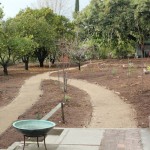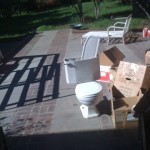Expo Line plants: Think first, proselytize later
Posted on | June 4, 2012 | 10 Comments
UPDATED Many of the same people whose passion and stamina forced Los Angeles City Council to adapt a low-water garden for City Hall are now campaigning for Phase Two stops of the city’s Expo Light Rail Line to be landscaped with native plants. Their movement, called LANative, has a website, a petition, and, most recently, support from an impassioned article in the Huffington Post.
Fellow travelers in the native plant movement, forgive me, but I can’t sing with the choir on this one. I can’t see how most of the powerful arguments for natives at City Hall to do with water efficiency, beauty, sense of place, pollinator benefit, run-off capture, leading by example etc. necessarily apply to a railway, which is less a garden setting than a fierce border twixt track and asphalt, steel and concrete.
In fact, as Phase Two of Expo Line construction presses forward, the most logical question might be: Why landscape around trains at all? Click here to keep reading
High good, low bad: Mead in May 2012
Posted on | June 1, 2012 | 2 Comments

Click on the cover to be taken to the "Aloud" program at the Los Angeles Public Library, where "Moral Ground" editor Kathleen Dean Moore will be part of a panel on western water on June 6, 2012.
Spoiler alert. It’s low bad for the monthly Mead report. The largest reservoir in the United States, which serves Southern California, Southern Nevada, Arizona, and Mexico, was at 1,119.38 feet at the close of May, 2012. That’s lower than it’s been for seven months, a mere 44 feet and change above a level that will invoke shortages in Arizona and Nevada. But! Now that doomsayers like me are all cheered up at any opportunity to remind wastrels with lawns, “We told you so,” it emerges that there is a more constructive voice in town. As clarification, it merits adding that the town is Los Angeles and the voice is that of philosopher Kathleen Dean Moore.
On Wednesday, June 6th, Moore will be among the panelists at the Los Angeles Public Library’s “Aloud” program. The theme: “The Elemental West: Reflections on Moving Water.” Invoking wild streams is a risky choice for an event in Los Angeles, where “moving water” is far more likely to be a ribbon of sprinkler run-off in a gutter than a stream. But if anyone can strike authentically elemental notes, it’s Moore. For those of you who haven’t heard of her, the Oregon State University professor of philosophy is editor of “Moral Ground: Ethical Action for a Planet in Peril,” a collection of essays by contributors as various as Archbishop Tutu, Bill McKibben and Gary Snyder on what it will take to prompt us to act on conclusive science that climate change is real and our water systems are in collapse. “Yes, global climate disruption is a technological issue that calls for our smartest and most far-sighted innovations,” she argues. “It is a scientific issue, calling for brave and honest research. It is an economic issue, calling for good thinking about meaningful, life-sustaining work and true wealth. It is a political issue, one that will inevitably involve contest and demand compromise. But we believe that climate change is fundamentally a moral issue, and it calls – it begs – for a moral response.”
In order to embrace conservation, we have to first decide, in Moore’s words, that “it’s wrong to wreck the world.” Anyone interested in conservation should be at the Los Angeles Public Library on June 6th at 7pm. For details click here.
Tags: Colorado River > Kathleen Dean Moore > Lake Mead > Los Angeles Public Library
God, lawn and me
Posted on | May 24, 2012 | 21 Comments
Sitting on the kitchen table is a rebate form from the local water company that I can’t bring myself to sign. Admittedly, a tidy slug of cash would be welcome for having replaced a toilet with an aquarium-sized tank with a low-flow version, and for having smothered and replaced a water-hungry backyard lawn with a mix of food and native plants that require a fraction of the water and provide many times the benefits. But even touching the rebate form feels corrupt. What kind of person expects to be paid for an act that is the opposite of sacrifice? Click here to keep reading
More rock for LACMA, please
Posted on | May 22, 2012 | 4 Comments
 The Los Angeles County Museum of Art compares the Levitated Mass to the construction of the Pyramids. After captivating the world’s press by parading the 340-ton boulder from Riverside to mid-city Los Angeles last winter, the latest news is that the museum is about to officially declare its rock open for visitors. Irony of ironies, just as our collective gaze is once again drawn toward this $10m publicity stunt, roughly 20m cubic yards of the kind of rock that can’t be levitated has built up around the headwaters of LA’s paved rivers. In contrast to the Levitated Mass, it’s not getting much press while the infrastructure that holds it can and should rightly be compared to the Pyramids. This is the flood control system of 14 dams and 162 debris basins that form what historian Jared Orsi describes as “a Maginot line” between the San Gabriel Mountains and the Los Angeles basin. It is the product of the headiest days of 20th century engineering, in part the work of General George Washington Goethals, the man who oversaw construction of the Panama Canal. And this flood control system on par with the Panama Canal and Pyramids is failing. Click here to keep reading
The Los Angeles County Museum of Art compares the Levitated Mass to the construction of the Pyramids. After captivating the world’s press by parading the 340-ton boulder from Riverside to mid-city Los Angeles last winter, the latest news is that the museum is about to officially declare its rock open for visitors. Irony of ironies, just as our collective gaze is once again drawn toward this $10m publicity stunt, roughly 20m cubic yards of the kind of rock that can’t be levitated has built up around the headwaters of LA’s paved rivers. In contrast to the Levitated Mass, it’s not getting much press while the infrastructure that holds it can and should rightly be compared to the Pyramids. This is the flood control system of 14 dams and 162 debris basins that form what historian Jared Orsi describes as “a Maginot line” between the San Gabriel Mountains and the Los Angeles basin. It is the product of the headiest days of 20th century engineering, in part the work of General George Washington Goethals, the man who oversaw construction of the Panama Canal. And this flood control system on par with the Panama Canal and Pyramids is failing. Click here to keep reading
Los Angeles built into a corner
Posted on | May 14, 2012 | 1 Comment
 LA’s improbable relationship with the San Gabriel Mountains makes the cover story High Country News: The list price was $1.125 million in August 2011, when Sotheby’s International Realty held the first open house for 1674 Highland Oaks Drive, in the Los Angeles suburb of Arcadia. Scented candles burned, classical music played and the air conditioner ran as potential buyers milled through the home’s three bedrooms, living room and combination den/dining room. Through sliding glass doors, a pool was visible in the rear garden; beyond it stood a sharply trimmed hedge. Past the hedge, in the ravine below it, a deep wash lay. Metropolitan Los Angeles ends at the edge of this canyon property, and above the wash, its steeply upland collar of national forest begins.
LA’s improbable relationship with the San Gabriel Mountains makes the cover story High Country News: The list price was $1.125 million in August 2011, when Sotheby’s International Realty held the first open house for 1674 Highland Oaks Drive, in the Los Angeles suburb of Arcadia. Scented candles burned, classical music played and the air conditioner ran as potential buyers milled through the home’s three bedrooms, living room and combination den/dining room. Through sliding glass doors, a pool was visible in the rear garden; beyond it stood a sharply trimmed hedge. Past the hedge, in the ravine below it, a deep wash lay. Metropolitan Los Angeles ends at the edge of this canyon property, and above the wash, its steeply upland collar of national forest begins.
Once, like all the canyons threading the foothills of the San Gabriel Mountains, Santa Anita Wash had a stream tumbling through it, lined with coast live oaks, sycamores and mountain mahogany. In the dappled light of the understory grew coffee ferns, delphinium, phacelia, monkeyflowers. Bears gorged on blackberries while scrub jays jealously cached acorns. By day, the canyon was atwitter with finches and bushtits, and at night, the tree frogs and crickets chorused.
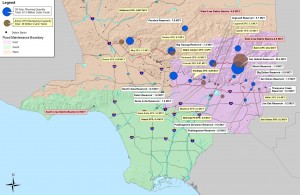
The dams and debris basins strung along the San Gabriel foothills, forming what Flood Control historian Jared Orsi describes as a "Maginot line" around the LA basin, are choked with mountain sediment. A 15-month review of what to do with it is online at the LA Department of Public Works. Until January 2011, a favored option was felling pristine oak woodland, called only "native vegetation" by Flood Control engineers, for conversion to dumps. Public comment on other options for disposal of the sediment is due by May 30th. Click on the map to be taken to the LA County Department of Public Works' draft sediment management 20-year strategic plan.
But on the day of the open house for what Sotheby’s called its “Highland Oaks Beauty,” there was no wild swell of twittering. No frogs, no crickets, no sign of a creek. The roughly 200 acres of sun-bleached concrete, gravel and sand in the canyon below resembled some kind of quarry. In a sense, that’s what it was — a pit gradually gouged out of the woodland over the last 85 years in an ongoing struggle to contain the mountains.
Click here to keep reading the High Country News story on how the felling of the Arcadia oak woodland behind Highland Oaks Drive forced a public 15-month-long review of LA County’s plans for disposal of sediment from behind its 14 dams and 162 debris basins. If you don’t have a subscription to this excellent non-profit environmental report, please consider signing up for a 30-day free online trial. A six month online subscription is only $12. Below is a Joshua Link photo of the Arcadia woodland before felling, along with a photo of mine taken in May 2011, almost five months after the razing of the woods to enlarge a Flood Control District sediment dump. 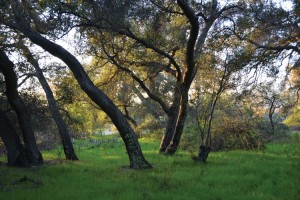
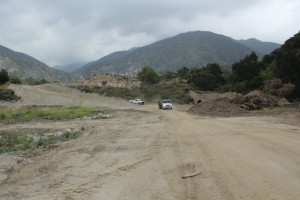
Tags: Arcadia woodland > Camron Stone > High Country News > LA County Flood Control District > Sediment Management Strategic Plan 2012-2032


